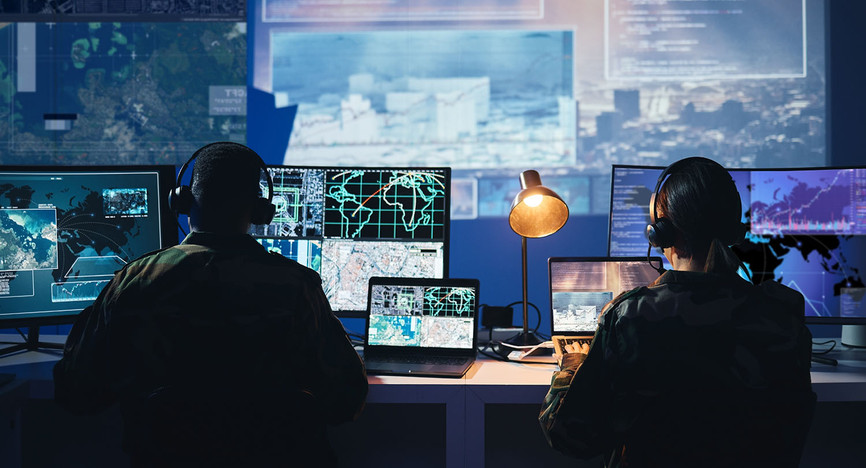Command & Control for the Modern Military

In the context of modern militaries, command and control refers to the processes, systems, and structures that enable military leaders to direct and manage their operating forces effectively. The original acronym for command and control (C2), has been expanded, broadened, narrowed, split, and divided in enumerable ways, from R2C2I to MDC2 to C4ISR. At the foundation of all of the various derivative acronyms, however, is command and control, the venerable C2.
Command and Control (C2)
Command, in this context, is the authority and responsibility of military leaders to make decisions and direct forces toward accomplishing missions. This involves setting objectives, issuing orders, and making critical decisions. Essentially, command is the decision-making authority.
Control, in C2, includes all the processes and systems that ensure orders are carried out. The control component is intended to guarantee that actions in the field align with the commander's intent. Also, control includes monitoring the results of orders, as well as the flow of information – up and down the chain of command.
Simply, command and control represents how military commanders lead. C2 encompasses the processes and technology that allow individuals and groups to combine efforts, resources, and information toward the completion of a goal or mission. C2 is as old as armed conflict itself. While the terms C2 or C5ISR would be foreign to Napoleon or Alexander the Great for example, the concepts would be immediately recognizable.
C2 Processes, Systems, and Structure
C2 processes are all aimed at reinforcing the OODA loop. The OODA loop is a decision-making model that represents the iterative and ongoing cycle of Observe, Orient, Decide, and Act. The OODA loop describes how decisions are made, and actions are executed in a changing and competitive environment. The goal is to make decisions and take action faster than the adversary, gaining an operational advantage.
- Observe: Gathering information from the environment, which includes intelligence, surveillance, and reconnaissance data. This is critical for understanding the current situation.
- Orient: Analyzing all of the information, understanding the context, and adjusting for factors like the enemy’s actions, terrain, or new intelligence.
- Decide: Making decisions based on the orientation phase, which includes setting objectives and determining a course of action.
- Act: Implementing the decisions through the chain of command with continuous monitoring.
C4ISR, C5ISR, C6ISR and Beyond
Among the various extensions to the C2 framework, C4ISR, C5ISR, and C6ISR are the most prominently used by the U.S. Department of Defense (DoD). These conceptual frameworks incorporate additional capabilities to enhance decision-making and operational effectiveness. As the military operational environment has evolved with technological advances and new challenges, these systems have expanded to address the increasing complexity of modern warfare.
C4ISR
C4ISR adds Communications, Computers, Intelligence, Surveillance, and Reconnaissance to the traditional C2 structure. C4ISR focuses on integrating communication systems and computer technology to gather and disseminate intelligence data, increasing situational awareness and enhancing decision-making. C4ISR emerged to manage the growing complexity of military operations, which required better communication systems, computers, and intelligence collection capabilities to manage information on the battlefield.
- Command: The exercise of authority based upon certain knowledge to attain an objective.
- Control: The process of verifying and correcting activity such that the objective or goal of command is accomplished.
- Communication: Ability to exercise the necessary liaison to exercise effective command between tactical or strategic units.
- Computers: The computer systems and compatibility of computer systems. Also includes data processing.
- ISR (Intelligence, Surveillance, and Reconnaissance): Systems that gather, process, and analyze data from various sensors, satellites, and reconnaissance assets to provide real-time situational awareness.
C5ISR
C5ISR builds directly onto C4ISR, incorporating Cyber capabilities, reflecting the growing importance of cyber warfare and the need to protect military networks from cyberattacks. C5ISR Emphasizes the defense and management of cyber operations, ensuring that communications, data, and network systems are secure, resilient, and capable of operating in contested cyber environments.
- Cyber: Cybersecurity and cyber warfare capabilities, both defensive (protecting military networks) and offensive (disrupting enemy systems).
C6ISR
C6ISR extends C5ISR by adding Combat Systems integration, which refers to the direct control and coordination of weapons systems and platforms, such as missiles, drones, and other automated or semi-automated weapons technologies. The inclusion of combat systems allows for a more comprehensive approach to military operations, ensuring that all systems, from command to intelligence to combat platforms, are networked and working cohesively. C6ISR evolved as weapons systems themselves became more advanced and interconnected. As a direct result of the development of networked weapons platforms, autonomous drones, and missile defense systems, combat systems are integrated into the C2 framework to ensure rapid, coordinated response across all domains.
- Combat Systems: Integration of weapons platforms, missile defense systems, drones, and other automated or semi-automated combat technologies.
The advent of C4ISR, C5ISR, and C6ISR reflect the growing complexity of warfare, and the role of technology in cross-domain military effectiveness. While each of these different frameworks build on one another, the traditional C2 components are still the fundamental, core components of each.
Over the past 35 years, Sealevel has developed and manufactured a broad range of critical communications, embedded rugged computing, and digital and analog I/O products for complex and demanding military applications. Sealevel products have been incorporated into C5ISR/Electronic Warfare Modular Open Suite of Standards (CMOSS) modules for use in a wide variety of US military vehicles. Sealevel is a member of the Sensor Open Systems Architecture (SOSA) Consortium, AUSA, NDIA, and the Association of Old Crows.
Categories:
